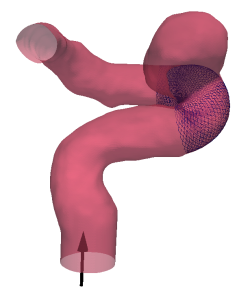Aneurysm Stent Modeling
Aneurysmal subarachnoid haemorrhage remains an important cause of stroke mortality and morbidity. Hemodynamic factors are considered to be a major factor in the progression and rupture of intracranial aneurysms. Flow diverting stent (FDS) is an emerging paradigm for treating traditionally difficult intracranial aneurysms. It is placed in the parent artery to divert the blood flow from the aneurysm sac and promote the progressive thrombosis. In the field of medical FDS, a numerical simulation is a tool of high importance for the investigation and development of new flow diverters. It is also used to assist patient-specific decision making, for example during a medical stent placement procedure for the consolidation of an arterial aneurysm. However, fully resolved simulations of the stent are often prohibitively expensive, opening the path for approximate but more efficient simulations framework which model the effect of the FDS through a coarse-grained, macroscopic approach.


Porous media model was proposed for this purpose, assuming that FDS can be described as a porous media, obeying Forchheimer’s law. However, FDS are not 3D porous media and a solution based on-screen model are more adapted. In this thesis, we develop a screen-based flow diverter model (SFDM) which circumvents deficiencies of some aspects of the porous media model.
Our framework is developed from the existing screen models which, as opposed to porous media models, are explicitly built to reflect the physics of thin porous structures, like a flow diverter stent. We first reviewed the hydraulic equations of screen in the literature, then proposed a 2D framework which is able to predict the pressure drop and flow deflection across a stent. The deflection part determined by the drag coefficient is different from the homogeneous porous media prototype.
The 2D SFDM is tested on several ideal aneurysms under various conditions, such as
different stent placements, varying homogeneous porosities and pulsatile inlet velocities. The model can effectively reduce the velocity and wall shear stress in the aneurysm sac as a fully resolved stent.
Afterwards, the framework of SFDM is extended to 3D and is applied for actual medical flow diverters in patient-specific aneurysms. The numerical tests show that the 3D SFDM can reproduce the results of direct numerical simulation both qualitatively and quantitatively, and are capable of reducing the simulation time by an order of magnitude or more. Additionally to the theoretical framework of the SFDM.
To simulate the fluid, this simulation tool uses Palabos which is an open-source solver based on Lattice Boltzmann method (LBM). The LBM force models and boundary conditions that we utilize for the simulations of stented aneurysms and SFDM are already integrated in the solver.
